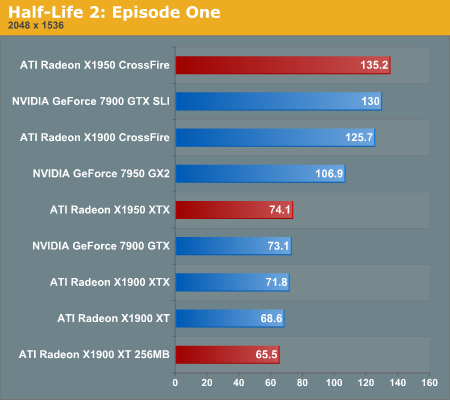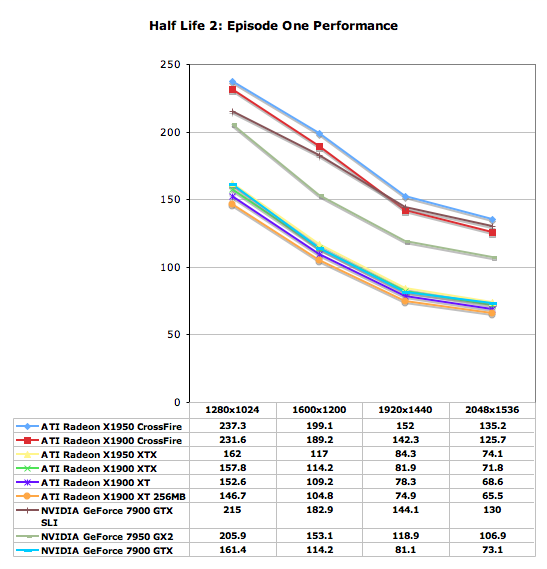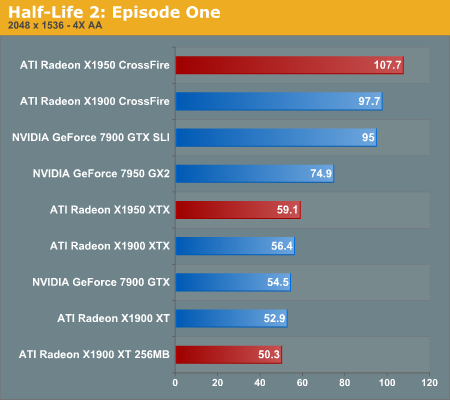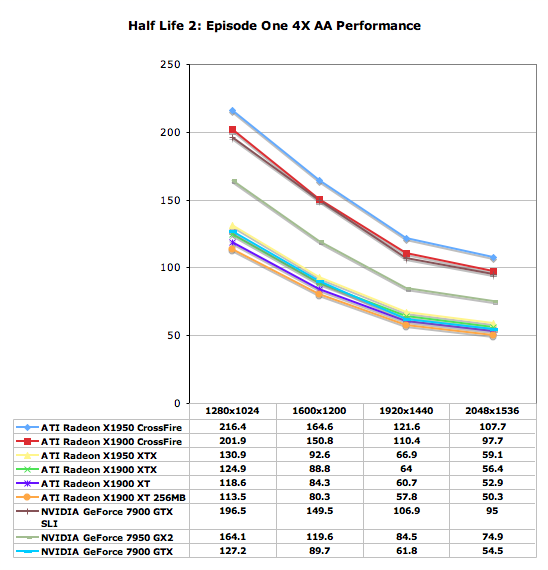ATI's New High End and Mid Range: Radeon X1950 XTX & X1900 XT 256MB
by Derek Wilson on August 23, 2006 9:52 AM EST- Posted in
- GPUs
Half-Life 2: Episode One Performance
Episode One of the new Half-Life 2 series makes use of recent Source engine updates to include Valve's HDR technology. While some people have done HDR that won't allow antialiasing (even on ATI cards), Valve put a high value on building an HDR implementation that everyone can use with whatever settings they want. Consistency of experience is usually not important enough to developers who care about pushing the bleeding edge of technology, so we are very happy to see Valve going down this path.
We use the built-in timedemo feature to benchmark the game. Our timedemo consists of a protracted rocket launcher fight and features much debris and pyrotechnics. The source engine timedemo feature is more like the nettimedemo of Id's Doom 3 engine, in that it plays back more than just the graphics. In fact, Valve includes some fairly intensive diagnostic tools that will reveal almost everything about every object in a scene. We haven't found a good use for this in the context of reviewing computer hardware, but our options are always open.
The highest visual quality settings possible were used including the "reflect all" setting which is normally not enabled by default. Antialiasing was left disabled for this test, and anisotropic filtering was set at 8x. While the Source engine is notorious for giving great framerates for almost any hardware setup, we find the game isn't as enjoyable if it isn't running at at least 30fps. This is very attainable even at the highest resolution we tested on most cards, and thus our target framerate is a little higher in this game than others.


Most of the solutions scale the same in Half-Life 2: Episode 1, with the possible exception of the 7900 GTX SLI setup hitting a bit of an NVIDIA driver inspired CPU limitation at 1280x1024. We can't really complain, as scoring over 200 fps is really an accomplishment in itself. With scores like these across the board, there's no reason not to run with AA enabled.


With even the slowest tested solution offering over 50 FPS at 2048x1536 4xAA, gamers playing HL2 variants can run with any of the high-end GPU solutions without problem. ATI does manage to claim a ~10% performance victory with the X1950 CrossFire over the 7900 GTX SLI, so if the pattern holds in future episodes ATI will be a slightly faster solution. The X1900 CrossFire configuration was also slightly faster than the SLI setup, though for all practical purposes that matchup is a tie.










74 Comments
View All Comments
Ecmaster76 - Wednesday, August 23, 2006 - link
Is it a GDDR3 or a DDR2 product?If the former, any chance it will crossfire with x1600 xt? Oficially I mean (methinks a bios flash might work, though x1650 is maybe a 80nm part)
coldpower27 - Wednesday, August 23, 2006 - link
No I don't think that would work.an X1650 Pro has 600/1400 Speeds so 100% sure is GDDR3, DDR2 doesn't exisit at such high clockspeed.
Genx87 - Wednesday, August 23, 2006 - link
Some of the other reviews had this x1950XT beating the GX2 almost every time, sometimes by a wide margin.I still cant get over the power\transistor\die size to performance advantage Nvidia has over ATI right now.
PrinceGaz - Wednesday, August 23, 2006 - link
Interesting. The first review I read was at where the X1950XTX beat or equalled the 7950GX2 every time, then here the reverse is true. I think I'll have to read more reviews to decide what is going on (it certainly isn't CPU limitations). Maybe 's focus on optimum quality settings rather than raw framerate is the reason they favoured ATI, and another is the clear fact that when it came to minimum framerates instead of average framerates ( posted both for all tests) the X1950XTX was especially good.In other words the 7950GX2 posted great average numbers, but the X1950XTX was playable at higher quality settings because the minimum framerate didn't drop so low. Hopefully some other sites also include minimum framerates along with graphs to clearly show the cards perform.
I remember a few years ago when ATs graphics card articles included image-quality comparisons and all sorts of other reports about how the cards compared in real-world situations. Now it seems all we get is a report on average framerate with a short comment that basically says "higher is better". Derek- I strongly suggest you look at how test cards and the informative and useful comments that accompany each graph. There may only have been three cards in their comparison but it gave a much better idea of how the cards compare to each other.
Anyway I'll not be getting any of these cards. My 6800GT has plenty of performance for now so I'll wait until Vista SP1 and the second-generation of DX10 cards which hopfully won't require a 1KW PSU :)
PrinceGaz - Wednesday, August 23, 2006 - link
It seems the comments system here uses the brackets in HardOCP's abbreviation as some sort of marker. Apologies for making the rest of the text invisible, please amend my comment appropriately. I was talking about HardOCP by the way, when I said they use minimum framerates and optimum quality settings for each card.JarredWalton - Wednesday, August 23, 2006 - link
Don't use {H} in the comments, please. Just like {B} turns on bold, {H} turns on highlighting (white text).
JarredWalton - Wednesday, August 23, 2006 - link
Ah, seems you figured that out already. ;) I need to see if we can disable that feature....haris - Wednesday, August 23, 2006 - link
Actually if you look at all of the reviews a bit more closely the sites the scores depend on which processor is being used for the test. It appears that nVidia cards tend to run better on Conroes(probably just means the games are slightly less cpu bottlenecked at the resolutions being tested) while ATi tends to run better on AMD systems(or when the cpu is slowing things down) Of course that is IIRC from the 5 reviews I skimmed through today.coldpower27 - Wednesday, August 23, 2006 - link
No just no X1950 XTX alone is not more powerful then the 7950GX2. Only in ATI favourable scenarios or where SLI flat out doesn't work will this occur.UNESC0 - Wednesday, August 23, 2006 - link
you might want to run dual monitors...